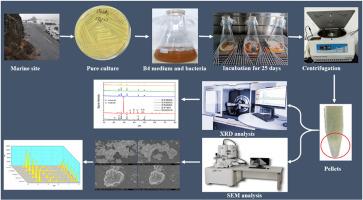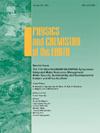从含甲烷水合物的海洋沉积物中分离并鉴定尿素分解钙化细菌,以用于生物固化应用
IF 3
3区 地球科学
Q2 GEOSCIENCES, MULTIDISCIPLINARY
引用次数: 0
摘要
在生物钙化过程中,微生物析出碳酸钙(CaCO3),形成多功能固体物质,从而促进环保材料的发展,减少碳排放。海洋细菌可以生成生物钙,以加固堤坝和防止海岸侵蚀。然而,海洋细菌在生成生物水泥以加固海岸结构和防治侵蚀方面的作用尚未得到充分了解。本研究调查了从含甲烷水合物的海洋沉积物中分离出来的 CaCO₃沉淀细菌的潜力。研究人员使用克里斯滕森尿素琼脂从巴基斯坦 Gawadar 海岸采集的海洋沉积物中分离出五种钙化海洋细菌。菌株诱导 CaCO3 沉淀,产生尿素酶。菌株被鉴定为假单胞菌(Pseudomonas putida)、高纬度芽孢杆菌(Bacillus altitudinis)、弧菌(Vibrio sp.)、芽孢杆菌(Bacillus sp.)和植物弧菌(Vibrio plantisponsor)。应用能量色散 X 射线光谱法、扫描电子显微镜法和 X 射线衍射法对方解石沉淀物和脉石沉淀物进行了鉴定和区分。在 5%氯化钠和 pH 值为 9.5-11 的条件下,分离菌的生长和沉淀潜力均达到最佳状态。与其他分离菌株相比,高纬度芽孢杆菌(ST4SD3)和芽孢杆菌(ST4SD1)在较高的 pH 值 10 和 pH 值 11 时产生更多的可溶性 Ca2+ (8532.53 毫克/升和 7581.98 毫克/升),有利于 CaCO3 的沉淀。结论是,海洋尿素分解细菌在生物固化方面具有巨大潜力,可以稳定含甲烷水合物的沉积物,改善土壤性质,保护沿海地区免受侵蚀,并在甲烷循环(一种温室气体)中发挥关键作用。我们建议进一步探索这类细菌在海洋建设和沉积物稳定方面的应用,以提高沿海基础设施的坚固性和使用寿命。此外,这种细菌还有利于从含有沉积物的未固结甲烷水合物中提取气体。本文章由计算机程序翻译,如有差异,请以英文原文为准。

Isolation and characterization of ureolytic calcifying bacteria from methane hydrate-bearing marine sediments for bio-cementation application
In bio-calcification, microbes precipitate calcium carbonate (CaCO3), forming versatile solid substances that promotes eco-friendly materials and reduce carbon emissions. Marine bacteria can generate bio-cements to strengthen dikes and combat coastal erosion. However, the role of marine bacteria in generating bio-cements for enhancing coastal structures and combating erosion is not fully understood. This study investigates the potential of CaCO₃ precipitating bacteria isolated from methane hydrate-bearing marine sediments. Five calcifying marine bacteria were isolated using Christensen's urea agar from marine sediments collected from Gawadar coastal, Pakistan. Bacterial strains induced CaCO3 precipitation producing urease enzymes. Strains were identified as Pseudomonas putida, Bacillus altitudinis, Vibrio sp., Bacillus sp., and Vibrio plantisponsor. Energy-dispersive X-ray spectroscopy, scanning electron microscopy, and X-ray diffraction were applied for the identification and differentiation of calcite and vaterite precipitates. The growth of isolates and precipitation potential were observed optimum at 5% NaCl and pH 9.5–11. Bacillus altitudinis (ST4SD3) and Bacillus sp. (ST4SD1) produced more soluble Ca2+ (8532.53 mg/l and 7581.98 mg/l) as compare to other isolates at higher pH 10 and pH 11, favorable for CaCO3 precipitation. It is concluded that marine ureolytic bacteria possess significant potential for bio-cementation, which can stabilize methane hydrate-bearing sediments, improve soil properties, protect coastal regions from erosion, and crucial in the methane cycle, a greenhouse gas. We recommend further exploration of such bacteria's applications in marine construction and sediment stabilization to enhance the robustness and longevity of coastal infrastructures. Furthermore, such bacteria could also be beneficial in extracting gas from unconsolidated methane hydrates containing sediments.
求助全文
通过发布文献求助,成功后即可免费获取论文全文。
去求助
来源期刊

Physics and Chemistry of the Earth
地学-地球科学综合
CiteScore
5.40
自引率
2.70%
发文量
176
审稿时长
31.6 weeks
期刊介绍:
Physics and Chemistry of the Earth is an international interdisciplinary journal for the rapid publication of collections of refereed communications in separate thematic issues, either stemming from scientific meetings, or, especially compiled for the occasion. There is no restriction on the length of articles published in the journal. Physics and Chemistry of the Earth incorporates the separate Parts A, B and C which existed until the end of 2001.
Please note: the Editors are unable to consider submissions that are not invited or linked to a thematic issue. Please do not submit unsolicited papers.
The journal covers the following subject areas:
-Solid Earth and Geodesy:
(geology, geochemistry, tectonophysics, seismology, volcanology, palaeomagnetism and rock magnetism, electromagnetism and potential fields, marine and environmental geosciences as well as geodesy).
-Hydrology, Oceans and Atmosphere:
(hydrology and water resources research, engineering and management, oceanography and oceanic chemistry, shelf, sea, lake and river sciences, meteorology and atmospheric sciences incl. chemistry as well as climatology and glaciology).
-Solar-Terrestrial and Planetary Science:
(solar, heliospheric and solar-planetary sciences, geology, geophysics and atmospheric sciences of planets, satellites and small bodies as well as cosmochemistry and exobiology).
 求助内容:
求助内容: 应助结果提醒方式:
应助结果提醒方式:


